 |
||
|
Amorgos: Home to the Improbable and Impractical
|
||
|
This easterly Cycladic island is full of ancient ruins, oddly-sited churches, dramatic scenery and a delightful Hora JONATHAN CARR
We leave Amorgos in an hour. There's just enough time to revisit Minoa, which we first approached at twilight two days previously after a long hike from Arkesini, further to the west. Minoa, Arkesini and Aegiali (about 20km to the northeast) were the island's three major cities from the Archaic period (7-6th centuries BC) until the Roman era. |
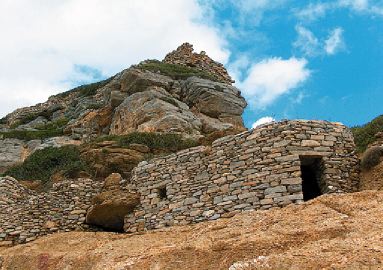 A view of ancient Arkesini, one of the island's three major cities from the Archaic period until the Roman era |
|
| On that first occasion, we managed to read a little about the site on the information board at the entrance before the light faded. We learned that traces have been found there of a late neolithic settlement from as early as the 4th millennium BC but that it is the Hellenistic city, dating from the 4th century BC, that is of most interest. Included among buildings already excavated and identified are a temple to Apollo, a gymnasium, a theatre and a temple to Dionysus Minoitis. Also, there is a Roman cistern and of particular interest to my travelling companion Tom and myself, a finely preserved water-borne latrine. Our first trip together, over 20 years ago, was to Kenya, where we were unlikely consultants on an unlikely project, to determine the market potential there for latrines - pit and water-borne. We can bore people very quickly on the subject. But this time there was nobody to tell and night had fallen. And we could not have got into the site in any case because excavations are ongoing and it is out of bounds. We walked round the city walls in starlight and imagined how formidable they must have been when approached from the sea. Now, two days later, with just an hour left on the island, we are back. An ouzo and biscuits party is underway in a bamboo shelter at the edge of the site. We are called over. And we quickly realise we have got lucky. Taking a break is a delightful team of enthusiastic archaeologists led by Lily Marangou and her former student George Gavalas. "You spent a long time looking at the archaeological collection in Hora yesterday, didn't you?" says George. "I saw you." Within minutes, he is taking us round the site. It is all fascinating but for us, of course, nothing more so than the latrine, a well-appointed four-seater in a room that was once plastered and decorated in red, yellow and green. Apparently, the structure was discovered by 19th-century traveller Theodore Bent, but he did not know what it was. Archaeologist L Ross actually peered inside and thought he was looking at fortification walls. It was none other than Lily herself, we learn, who excavated them. She is rightly proud of the discovery and we congratulate her warmly, all set to surprise her with our specialist knowledge. But she has more important things to discuss. She wants to know if we have been to the Old Tower at Arkesini. No, we haven't. No? Well, why not? she scolds. "It's the most important monument on the island." |
||
| An ancient site is a good place to start on this most easterly Cycladic island. There have been some extraordinary finds already and much more is likely to be on the way. We know Amorgos was settled from at least the 4th millennium BC and prehistoric cemeteries have yielded ceramics, fine metalwork and Cycladic marble figurines, including the largest early (2800-2300BC) such statue found so far. From the Classical era onwards there is archaeological and documentary evidence that pieces together a good part of the island's story from then until now. Of particular cultural interest is the fact that the 7th century BC iambic satirist Simonides (born on Samos) came to live here. He had much to say about the women of the island, both flattering (the best is like a queen bee) and not (the flaws of women he |
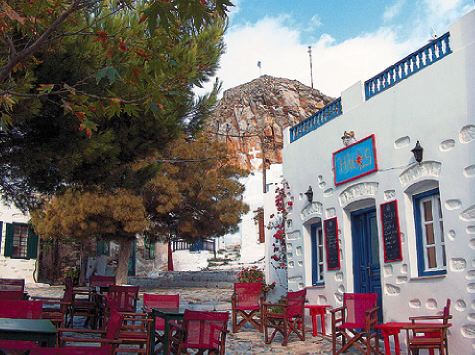 A large eucalyptus tree shades Loza Square's cafes from the morning sun |
|
| knew are compared to less admirable species of animals). The women may also have been behind their island's name. We know that in the 5-4th centuries BC they were weaving fine transparent "Amorgean tunics", often dyed purple, from the local amorgos flax. The export trade in them thrived. The glory of Classical and Hellenistic Amorgos marked the zenith of the island's development. Afterwards, as elsewhere in the Cyclades, it fell under Frankish and Ottoman control and was the frequent target of piracy until the 18th century when agriculture and trade once more flourished. Piracy, though, did strike one more time before Greek independence, when Maniots under Captain Stekoulis carried out a particularly brutal raid in 1797. Those days, thankfully, are now long gone and we tourists are the only pirates to come visiting. |
||
On the rocks Arriving at night, the boat often calls in first at the port of Aegiali before running in a southwesterly direction along the coast, skirting round the islet of Nikouria (a former leper colony), before rounding the headland which shelters the bay of Katapola. This gives you a sense of Amorgos' length (about 29 kilometres) but not its width. Together with Folegandros, it is one of the narrowest of the main Cycladic islands, only 2.5 kilometres across at one point, and its shoreline is mostly sheer and rocky. And rocks, on Amorgos, are used in the most imaginative ways. |
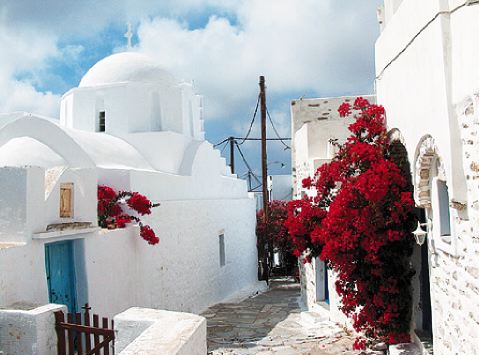 Hora is one of the best-preserved island capitals in the Cyclades |
|
| Dominating the old Kastro area of Hora, the island's capital that hides in the mountains above Katapola, is a rock that is 64m high and for over 1,500 years one side of it has been home to the Keraleousa church. Exactly how is hard to say. Attached, wedged, divinely glued.... "Improbable," says Tom in admiration. But this will prove to be merely an aperitif for the island's most famous Christian shrine which is to be found hanging onto cliffs below the Hora. |
||
| The legend is that Hozoviotissa was not always where it is now. People in the 8-9th centuries were more sensible but less fortunate than those who came after. They built at a lower level, but their church was destroyed and the tools were miraculously removed to a higher and far more inaccessible spot which was, according to a document signed much later in 1583 by Ecumenical Patriarch Jeremiah II "the Great", a site "once considered by the locals an inaccessible 'God-forsaken place'." The chisel of the master builder was found inserted into the rock where the monastery should be built (it is said to be the one on display in the chapel today). Next, one of those unmanned boats with just an icon on board appeared and this particular icon of the Virgin Mary allegedly came from Hozova in Palestine. God had spoken. |
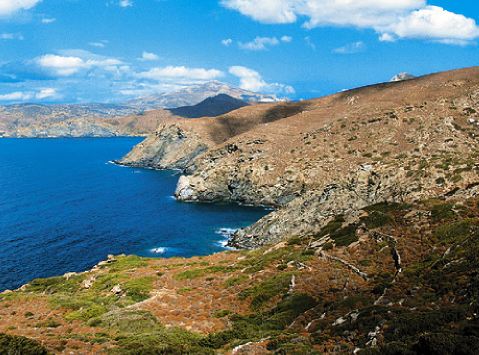 The path from ancient Arkesini to Katapola offers views of Amorgos' cliffy shoreline |
|
| And so the new monastery of Hozoviotissa was founded by Alexis Comnenus I of Byzantium in the 11th century and it is still clinging to those same vertical cliffs today at a present height of 45m and a width of just 4.6m, with seven levels and three monks. Windows stare out at the Aegean, all different sizes and irregularly spaced, and two huge buttresses seem to have taken on the responsibility of making sure it doesn't all come tumbling down. Quite simply, off its rocker. One of the maddest-looking buildings I have ever seen. "Impressively impractical," is Tom's assessment. |
||
| Being a monastery, practicality is hardly the issue. But formality is. There are signs at the bottom of the paved steps leading up to Hozoviotissa reminding visitors of the discriminatory dress code. The wording is a little ambiguous but the essence of it is that men need to wear trousers but women mustn't. Entrance is through a low marble door frame, and a staircase beyond leads to the upper levels. At the top of the stairs is a minder for the monks whose task is to enforce the clothing rules. Once in his line of sight, you don't normally make it beyond the first two steps in the wrong attire. For people dressed appropriately more steps lead up via more levels to the chapel at the top. It is rather a wonderful little sanctuary, with its icons and treasures and incense and one of |
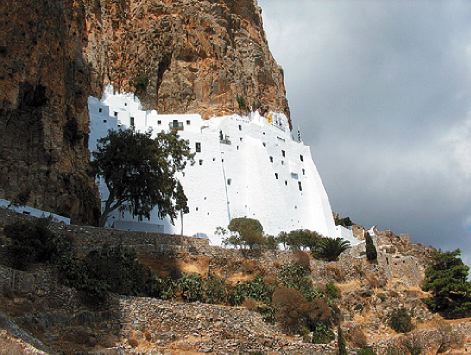 The breathtaking Hozoviotissa monastery hangs onto cliffs below Hora |
|
| the monks is stationed there to explain a little about the monastery's history. Outside is a terrace that can make you feel quite dizzy if you lean over the edge and look down into the waters of the Aegean, rather a long way below. Next stop is a reception room, the walls hung with portraits of former monks (and military leaders), where visitors are given a glass of the local honey and raki liqueur and a loukoumi. Then comes the descent. And since there is only that one narrow staircase leading up from the bottom level, there can be some waiting time. The monk's minder has to act like a cuckoo clock. Out he pops to the top of the stairs to give the same old message, politely, to yet another incorrectly dressed visitor, and back he comes into the waiting room, slapping his forehead and rolling his eyes to vent his frustration. Out he pops, back he comes. But now, as we wait, he pops out for a long time. An unholy argument is in progress in Greek. He is facing up to some irate women who have just exhausted themselves climbing the steps from their tour bus and have no intention of not seeing the monastery. Back he comes, at last, and beckons for us to go down, evidently still unaware of just what he is up against. We descend to find the stairs blocked and we don't know where to look. Four steps below us a woman has removed her trousers and her husband (presumably) is removing his shirt so she can wrap it round her thighs and pass it off as a skirt. We edge past and leave them to it. Amorgos' Hora is one of the best-preserved capitals in the Cyclades (thanks in large part, we are told, to Lily Marangou's efforts) and one of the pleasures of being on the island is to get lost in its quiet alleys, designed with foresight not just to keep out pirates but cars and motorbikes as well. Originally built as a retreat from the men of the black sails, the medieval part of the town centres round the Kastro rock with the improbable church, a warren of arches and passages and thick stone walls. Not far below is Loza, the main square, its cafes shaded from the morning sun by a large eucalyptus tree, the traditional blues and whites interrupted by the surprise of a green door or a wall of purple bougainvillea. And from there the streets spread out in a maze of steps and corridors full of barrel-vaulted churches and houses with iron balustrades and whitewashed walls that seem to bubble from all the little indentations that mark this style of Cycladic building. Are these purely decorative or do they act as a kind of cooling system? And for how long have they been 'traditional'? Lily would know. One day, we walk from Hora via Hozoviotissa Monastery to Aegiali. It looks impressive on the map, a route that probably covers half the island and follows its spine along the narrowest section. And it is impressive, not least because you walk beneath the limestone ridge that runs down from Mount Prophet Elijah (698m) and cross over from one side of the island to the other. This is the best way to get an idea of how steep and narrow this old island is and why, in antiquity, Aegiali must have seemed so independent of the other city states - Arkesini and Minoa. It is quite a trek, the path winding and uneven. The sun is already going back down into the sea when we meet a couple of cheerful goatherds. Where have you come from, they ask. Hora. How long did it take? Oh, about an hour, we reply. They grin. In that case, it'll only take you another ten minutes to get to Aegiali! Off they go, chuckling. It will take us a good hour-and-a-half. Twilight restores the richness of colour to the land and sharpens the contours of the Little Cyclades, the islands that lie to our north-west across a pool of calm water. On evenings like this, it is easy to forget how treacherous the sea can be and what a long and turbulent history these empty hills have witnessed. We leave the path and go cross country towards the distant church of St Mamas and from there into tidy Pano Potamos which leads down, via many steps, into the charming little port of Aegiali. The second time we have been here. And the second time at night. We really ought to see it in daylight. Next time. Because with one hour left on the island, over ouzo and biscuits, Lily Marangou has extracted a promise that there will be a next time. It is very important to visit the Old Tower at Arkesini, she repeats, when we try and fail once again to get in a word about our own expertise in latrines. "So what happened there?" we ask. "Everything," says Lily, "though we don't know yet exactly what." How to get there |
||
|
|
|
|
|
|
||
(Posting Date 15 October 2007) HCS readers can view other excellent articles by this writer in the News & Issues and other sections of our extensive, permanent archives at the URL http://www.helleniccomserve.com./contents.html
All articles of Athens News appearing on HCS have been reprinted with permission. |
||
|
||
|
2000 © Hellenic Communication Service, L.L.C. All Rights Reserved. http://www.HellenicComServe.com |
||

